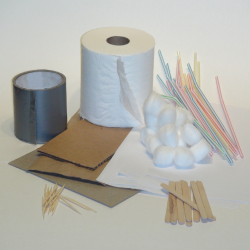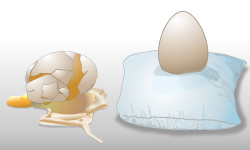|
 Create a container or package that contains a raw egg and protects it from breaking when dropped from a height of 2 m.
Create a container or package that contains a raw egg and protects it from breaking when dropped from a height of 2 m.
Materials: 20 straws, 10 popsicle sticks, 20 toothpicks, 10 sheets of newspaper or a roll of white craft paper (or bathroom tissue), toilet paper, length of duct tape, 1 set of cotton balls, length of string (or nylon thread), and a supply of cardboard.
Other constraints: maximum mass of 1 kg, maximum size of 30 cm on a side, no use of bubble wrap, no parachutes, and the shock-absorbing material must be located inside the container. 
|
 If you drop an egg, the hard floor exerts a sudden and strong force on the egg. The egg will rapidly lose its momentum and ... splat! Now imagine dropping it on a pillow. The pillow will allow the egg to change its momentum over a longer time, which corresponds to the pillow exerting a weaker force on the egg throughout the process. The same principle lies behind automobile air bags, which cushion a passenger in a collision by increasing the time over which momentum changes.
If you drop an egg, the hard floor exerts a sudden and strong force on the egg. The egg will rapidly lose its momentum and ... splat! Now imagine dropping it on a pillow. The pillow will allow the egg to change its momentum over a longer time, which corresponds to the pillow exerting a weaker force on the egg throughout the process. The same principle lies behind automobile air bags, which cushion a passenger in a collision by increasing the time over which momentum changes. 
 |
An alternate expression of Newton’s second law is that the force on an object is equal to the change in its momentum divided by the elapsed time, i.e., F = Δp/Δt. No matter what method is used to cushion the egg, its change in momentum Δp will be the same. But cushioning the egg will change the length of time Δt over which the momentum will change. For a hard floor, Δt is small and the force exerted on the egg is large, causing the egg to break. For a pillow, Δt is larger and the force exerted on the egg is small, so the egg is unbroken. 
|
Choose one or two parameters that might be varied: number of embedded containers within containers, padding material, configuration of padding material (wadded, crumpled, layered), shape of containers and/or device holding the egg, and so on. Write a testable hypothesis on the effect of each parameter. Sketch a design on paper that will allow you to change these parameters to test how variants will perform. 
|
Create the prototype of your design. Were there unforeseen problems you encountered when constructing the prototype that led to immediate design changes? If so, then update your design, changing materials or equipment as necessary. 
|
Test versions of your prototype by varying the design parameters you identified. For each test of your design, identify the controlled variable(s). Before running a test, agree upon your hypothesis and what you will be evaluating at the conclusion of each test, such as damage to the container or enclosed object. 
|
Analyze the tests to determine which design elements produce the best performance relative to the design criteria. What evidence led you to those conclusions? Document the strengths and weaknesses of your prototype in your report. 
|
Based on your evaluation, redesign your container using the design elements that best meet the evaluation criteria. Then prototype and test it in preparation for the final evaluation. 
|
Your teacher will evaluate each submitted container by measuring its mass (less than 1 kg), measuring its dimensions (width ≤ 30 cm), and dropping it from a height of 2 m. If your container passes this test, how high can you drop it without the egg breaking? Afterward, each student group will present to the class a short summary of their design concepts and performance. As a class, discuss what design elements performed best. For extra credit, revise your container design to include the best elements and test it. 
|
| |
|

